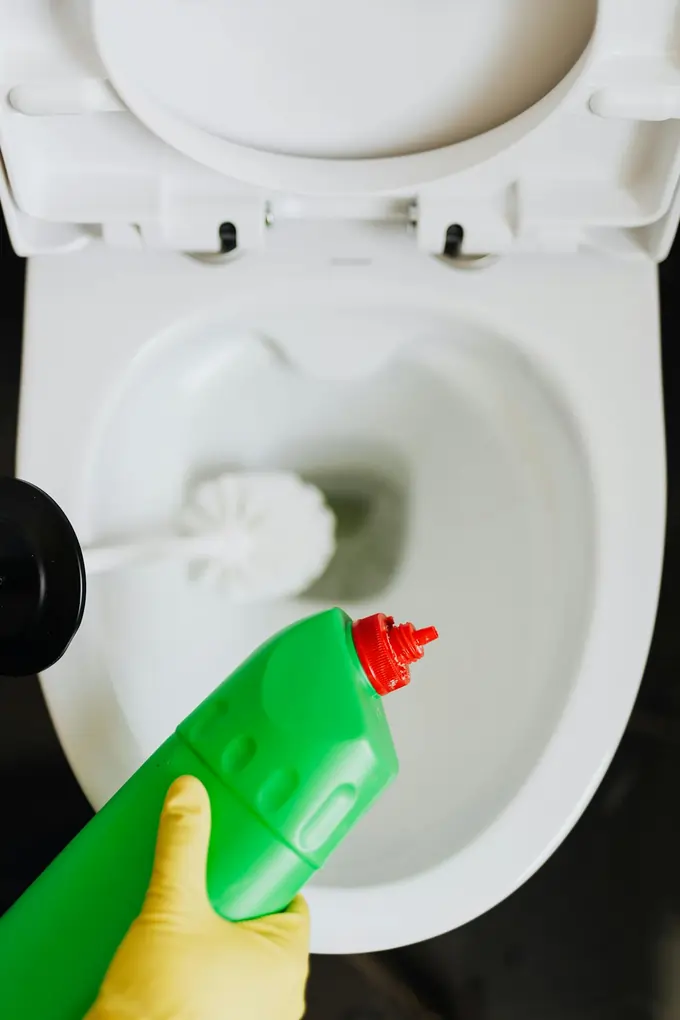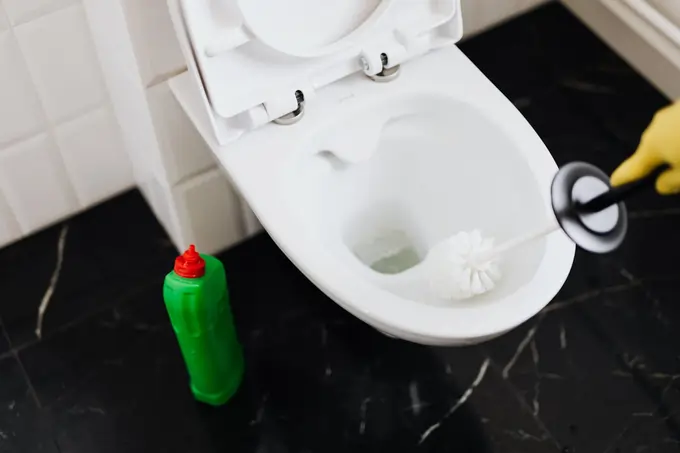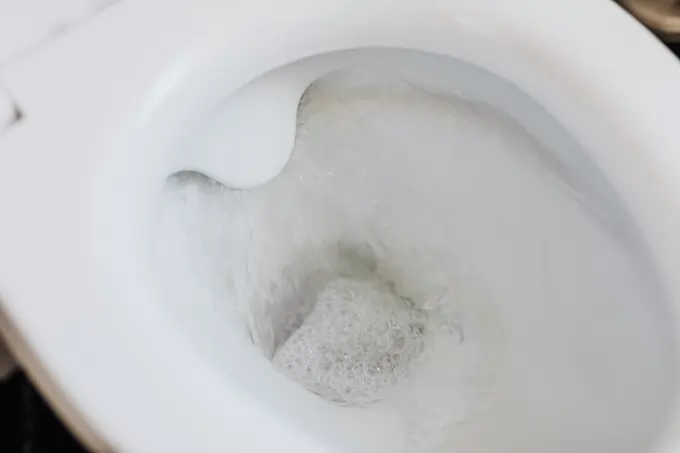Are you facing a clogged toilet nightmare? 🚽💩
Don’t panic!
You can unclog toilet without plunger.
In this article, we’ll explore simple, effective methods to fix your clogged toilet.
You’ll learn how to use common household items to clear stubborn blockages.
We’ll also cover what to do if your toilet overflows and when to call a professional.
Let’s dive in and solve your toilet troubles!
How Can You Unclog Toilet Without Plunger?
A clogged toilet can ruin your day.
But what if you don’t have a plunger?
Don’t worry, there are several ways to unclog a toilet without this common tool.
Let’s explore some easy DIY solutions.
Using Dish Soap and Hot Water
This method is simple and often effective.
Pour 1/4 cup of dish soap into the toilet bowl.
Let it sit for 5-10 minutes.
Follow with a gallon of hot (not boiling) water.
The soap helps break down waste and lubricate the pipes.
Hot water adds pressure to flush the clog.
Wait 10-15 minutes and flush.
If it doesn’t work the first time, try again.
Applying Baking Soda and Vinegar
This classic combination can work wonders on toilet clogs.
Pour 1 cup of baking soda into the toilet bowl.
Follow with 1 cup of white vinegar.
The mixture will fizz and bubble.
Let it sit for 20-30 minutes.
Flush with hot water.
This method is eco-friendly and safe for your plumbing system.
Homemade Drain Cleaning Solutions
You can create effective drain cleaners with household items.
Mix 1/4 cup salt, 1/4 cup baking soda, and 1/2 cup vinegar.
Pour the mixture into the toilet bowl.
Give it a rest for 15 minutes.
Flush with hot water.
This solution can break down minor clogs and freshen your toilet.
What Household Items Can be Used to Unclog Toilet Without Plunger?

No plunger? No problem!
You can use everyday items to unclog toilet without plunger.
Let’s explore some creative solutions.
Wire Hanger Method
A wire coat hanger can be a makeshift toilet snake.
Unwind the hanger and create a small hook at one end.
Wrap the hook with a cloth to protect the porcelain.
Insert the hanger into the toilet drain.
Gently push and pull to dislodge the blockage.
Be careful not to scratch the bowl.
This method can be effective for removing clogs near the surface.
Plastic Bottle Technique
A plastic bottle can create suction to remove clogs.
Fill a 2-liter bottle with warm water.
Place your thumb over the mouth of the bottle.
Insert the bottle into the toilet bowl, mouth down.
Remove your thumb and squeeze the bottle forcefully.
The water pressure can dislodge the blockage.
Repeat if necessary.
This technique is worth a try for stubborn clogs.
Toilet Brush Strategy
Your toilet brush can do more than just clean.
Insert the brush into the toilet bowl.
Push and pull rapidly to create a plunging motion.
This action can help break up the clog.
Be prepared for splashing and wear rubber gloves.
While not as effective as a plunger, it’s a quick fix in a pinch.
Can Baking Soda and Vinegar Unclog a Toilet?
Baking soda and vinegar are a powerful duo for unclogging toilets.
But how exactly does this method work?
Let’s break it down.
Chemical Reaction Explained

Baking soda (sodium bicarbonate) is a base.
Vinegar (acetic acid) is an acid.
When combined, they create a fizzing reaction.
This reaction produces carbon dioxide gas.
The bubbling action helps break up clogs.
It’s a natural, non-toxic alternative to chemical drain cleaners.
Step-by-Step Baking Soda and Vinegar Method
- Pour 1 cup of baking soda into the toilet bowl.
- Add 1 cup of white vinegar slowly.
- Let the mixture fizz for 20 minutes.
- Pour a kettle of hot water into the bowl.
- Flush the toilet.
- Repeat if necessary.
This method can clear many common toilet clogs.
Precautions When Using This Method
Don’t use this method if you’ve already tried chemical drain cleaners.
The reaction could create harmful fumes.
Avoid using boiling water, as it can crack the porcelain.
Don’t flush more than twice if the clog persists.
Excessive flushing can cause overflow.
If the clog remains, try a different method or call a plumber.
How to Handle a Toilet Overflow?
A toilet overflow can be a messy disaster.
But quick action can minimize damage.
Here’s what you need to know.
Stopping the Overflow
Locate the shutoff valve near the base of the toilet.
Turn it clockwise to stop water flow.
If there’s no valve, remove the tank lid.
Lift the float ball or cup to stop water from entering the bowl.
Don’t flush again until the clog is cleared.
These steps can prevent further overflow.
Cleaning Up After a Toilet Overflow

Put on rubber gloves and old clothes.
Use towels or a mop to soak up water.
Disinfect the area with bleach or a cleaning solution.
Wash or dispose of any items that touched the water.
Open windows to ventilate the area.
Proper cleanup prevents health hazards.
Prevent Future Overflows
Don’t flush excessive amounts of toilet paper.
Avoid flushing non-flushable items.
Teach children proper toilet use.
Keep a plunger or toilet auger handy.
Consider installing a low-flow toilet.
Prevention is key to avoiding future clogs and overflows.
When Should You Call a Plumber for a Clogged Toilet?
Sometimes, DIY methods aren’t enough.
Knowing when to call a professional can save time and prevent damage.
Let’s explore when to seek expert help.
Signs You Need Professional Help
The clog persists after multiple attempts to clear it.
You hear gurgling sounds in other drains when flushing.
Water backs up in sinks or showers when you flush.
There’s a foul odor coming from the drains.
You frequently experience clogs.
These signs may indicate a more serious plumbing issue.
What Plumbers Can Do That You Can’t
Plumbers have specialized tools like toilet augers and drain snakes.
They can inspect pipes with cameras to identify hidden problems.
Professionals can safely remove stubborn or deep clogs.
They can diagnose and fix underlying plumbing issues.
Plumbers ensure the job is done right the first time.
Cost of Plumbing Services for a Clogged Toilet
The average cost to unclog a toilet ranges from $100 to $275.
More complex issues can cost $500 or more.
Many plumbers charge a flat rate for standard services.
Some offer emergency services at higher rates.
Always get a written estimate before work begins.
While costly, professional service can prevent more expensive repairs later.
Summary
In conclusion, unclogging a toilet without plunger is possible with common household items.
From dish soap and hot water to baking soda and vinegar, these methods can save you from a plumbing emergency.
Remember to handle overflows quickly and know when to call a professional.
With these tips, you’re well-equipped to tackle toilet troubles.
Don’t let a clogged toilet ruin your day – try these methods and flush your worries away! 🚽✨
People Ask
How do you unclog a toilet without a plunger?
So, your toilet is clogged and there’s no plunger? Don’t stress! The quickest way to fix a clogged toilet without a toilet plunger is to grab a gallon of hot water. First, fill a bucket and pour it from waist height into the bottom of the toilet. This can help loosen the clog and make the toilet flushing properly again.
If that doesn’t work, mix some hot water and dish soap. Let it sit for a bit to help dislodge the clog. Try again, and hopefully, you’ll see the water level in the bowl drop. If the toilet from waist still has much toilet paper and dirty water, repeat the process until you clear the pipes.
What can I pour down my toilet to unclog it?
Hey there! If your toilet’s clogged and you’re looking for a DIY fix, here’s a tip: pour one cup of baking soda and two cups of vinegar down it. Let it fizz and dissolve any toilet paper causing the clog. After about half an hour, add hot water to help clear things out.
But wait, that’s not all! For stubborn clogs at the bottom of the tank, you might need to use a closet auger or a drain hole tool. Before you do, make sure there’s no water before adding anything new.
If this doesn’t work, you could try a 🪠 to gently pull the clog out. Don’t forget, the cause of the clog is often stuff like wet wipes, so always be cautious. In extreme cases, you might need to remove the toilet and use a hook to manually remove the clog.
You’ll want a pail ready to catch any excess water that could spill. Good luck and may your toilet flush freely!
What can I use instead of a plunger?
Can’t use a toilet because it’s clogged? No worries! Instead of rushing to buy a plunger, try pouring hot water down the excessive toilet bowl. The heat helps toilet paper dissolve, clearing the clogged area. Or, you can invert a wire coat hanger, use the hook end to dislodge whatever’s getting clogged. Give it a try before you panic!
What product can I use to unclog a toilet without a plunger?
So, if you need to unclog a toilet without a plunger, try hot water and dish soap. Just squirt some soap in there and then pour a bucket of hot (not boiling) water. The combo of soap and hot water could help break things down and get everything flowing again.


